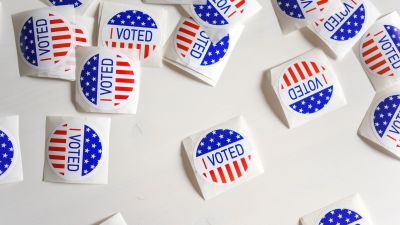US election 2020: A three-minute guide to how it works

The US presidential election 2020 is on Tuesday 3rd November and Americans will decide who they want at the head of the US government and in the White House for the next four years - Joe Biden or Donald Trump.
But how does the process of electing a president actually work?
Here's a quick guide.
How does the electoral college work?
When Americans vote for their president, they will not be technically voting for Biden or Trump.
Instead they will be electing members of the electoral college – known as electors - who choose the president and vice-president.
Will Trump Win? Listen to our US election podcast below and subscribe on Apple Podcasts or Spotify
Each state gets a number of electors based on its population and the number of senators and representatives it has in the U.S. Congress.
California has the most electors - 55 - but some states have just three electoral votes - Wyoming, Alaska and North Dakota and Washington DC.
The District of Columbia, while not a state, is allocated three electors and treated like a state for purposes of the electoral college.
There are 538 electors in total and the presidential candidate needs the votes of at least 270 electors - more than half of all electors - to win the presidential election.
In 48 states, the winner of the state-wide popular vote gets all the electoral votes for that state.
For example, whether the Democrat candidate wins 99% or 51% of the vote in that state, they would still receive all the state’s 55 electoral college votes.
However, two states – Maine and Nebraska – assign their electors using a proportional system, instead of the winner-takes-all approach used in the rest of the states.
So does the candidate with the most votes always win?
No, as the president is not chosen by a national popular vote, but by the electoral college vote.
In the majority of states, whichever candidate wins the most votes - even if the margin of victory is only 50.1% to 49.9% - takes all the electoral votes.
This means that candidates can still receive enough college electoral votes to win, while receiving a smaller share of the popular vote than their rival.
This happened in the 2016 election when Hillary Clinton received almost three million votes more than Donald Trump. But while Clinton won the popular vote, Trump received a majority of electoral college votes across all the states and therefore won the election.
It also happened in 2000, when George Bush received fewer popular votes than Al Gore, but received a majority of electoral votes.
Do candidates focus on some states more than others?
The electoral college system means candidates will target ‘swing states’ rather than focusing on states which consistently vote for the same party.
Battleground or ‘swing states’ are the states where the vote has swung to either the Democrats or Republicans in past elections.
Presidential candidates tend to target battleground states with campaign visits and advertising – in the 2016 election, two thirds of campaign events were held in just six states.
There is some variation between pollsters on the ‘swing states’, but the key battleground states in this year's election - and the number of electoral college votes up for grab in each - are:
Alaska (3 votes)
Arizona (11 votes)
Florida (29 votes)
Georgia (16 votes)
Iowa (6 votes)
Maine (4 votes)
Michigan (16 votes)
Minnesota (10 votes)
Nebraska (5 votes)
Nevada (6 votes)
New Hampshire
North Carolina (15 votes)
Ohio (18 votes)
Pennsylvania (20 votes)
Texas (38 votes)
Wisconsin (10 votes)
Watch special ITV News live coverage of the US election results from 11pm on Tuesday 3 November on ITV